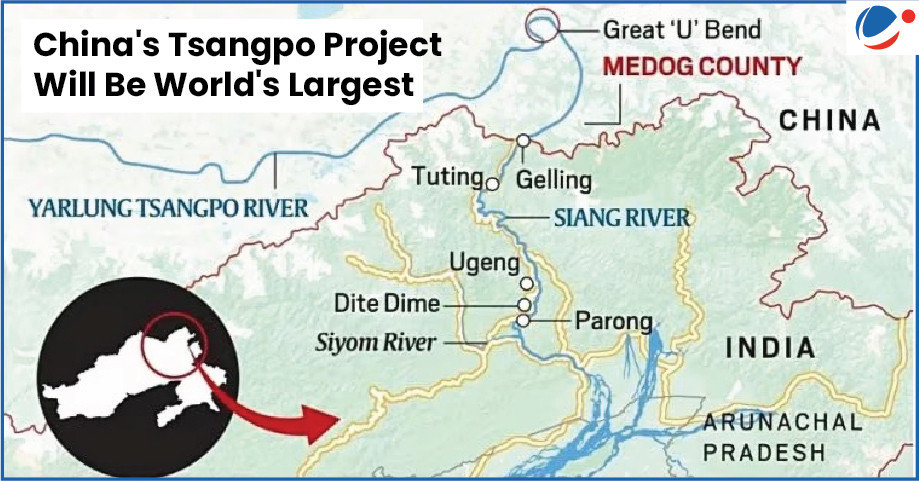Why in the News?
China started construction of its Medog mega dam project on the Yarlung Zangbo (Brahmaputra in India) River in Tibet.
More on the News
- Beyond power generation, the project supports Beijing's goal of industrialising Tibet.
- China presents the Medog (Motuo) Dam project as both a renewable energy initiative and an economic boost for Tibet, supporting its goal of carbon neutrality by 2060.
About the Medog Hydropower Project
- Scale and Capacity: Once completed, it will surpass the Three Gorges Dam as the world's largest, potentially generating three times more energy.
- Location: Situated at the Great Bend of the Yarlung Tsangpo River in Tibet, near the Arunachal Pradesh border.
- Project design: Marketed as a run-of-the-river project, it will feature five cascade hydropower plants, reservoir-like structures, diverting up to half of the river's flow.

Key Concerns of the Project
- Geopolitical Concerns:
- Disruption Concerns: Disruption in water flow will affect Agriculture, Food security, and hydro projects in Northeast India.
- E.g. Siang River disaster (2000).
- Security Risks: Seen as a potential water bomb in times of tension.
- Disruption Concerns: Disruption in water flow will affect Agriculture, Food security, and hydro projects in Northeast India.
- Water Resource Competition: The Brahmaputra basin faces India-China-Bangladesh competition, driven by dams and diversion plans, posing risks to human security and regional stability.
- Environmental Impact:
- Disruption of sediment flow vital for the Ganges-Brahmaputra Delta.
- Threat to 218 fish species, including Hilsa and Mahseer, jeopardising two million livelihoods.
- Disaster Vulnerability:
- Located in Seismic Zone V, prone to earthquakes and landslides.
- A 7.5-magnitude quake in Tibet in December 2024 underscored the risk of catastrophic dam failure.
Existing River Water Cooperation Mechanism between India and China
|
Way Forward
- India's Potential Response:
- Strategic countermeasures: India plans the Siang Upper Multipurpose Project in Arunachal Pradesh as a hydropower response to China's upstream advantage on the Brahmaputra.
- Niti Aayog proposed a multipurpose project in the Siang region in 2017.
- Transparency Demands: Seek full disclosure of technical details, environmental studies and seismic safety plans, and press for suspension until these are addressed.
- Strategic countermeasures: India plans the Siang Upper Multipurpose Project in Arunachal Pradesh as a hydropower response to China's upstream advantage on the Brahmaputra.
- Regional Coalition: Unite downstream nations to demand legally binding water sharing accords under the 1997 UN Water Convention with hydrological data sharing, joint environmental assessments, etc.
- Transboundary Cooperation: Push for mechanisms similar to China's agreements with Kazakhstan on shared rivers to safeguard India's co-riparian rights.
- Water Security Framework: Explore a South Asia Water NATO for Brahmaputra, Indus and Ganges states modeled on collective security to ensure data transparency, dispute resolution, disaster readiness etc.
- Best Practices and lessons from the Nile Basin Initiative and the Mekong River Commission can be adopted.
Conclusion
The Yarlung Tsangpo project underscores the need for urgent, cooperative water governance. Without transparency and equitable sharing through mechanisms like a middle riparian coalition or a South Asia Water NATO, it risks triggering ecological damage, economic loss, and regional instability.



